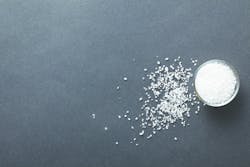Not all glasses of water are created equal. Water may smell or taste bad because of a harmless side effect from the environment, or it could be a sign of a more serious issue that requires immediate action. With more than 316 contaminants found in water supplies throughout the U.S., a number of reasons explain why water may have an odd taste or smell. It is important to identify the source of the odor to ensure safe, clean drinking water.
An unwanted odor coming from drinking water is often the sign of bigger issues plaguing the tap or pipes. Often this smell does not signify the presence of a harmful contaminant, but it could indicate that the drinking water is not the cleanest and should be inspected to be restored to its purest state. By the time drinking water has left the treatment plant and arrives at the tap, several possible contaminants could have affected it along the way. Sometimes water may taste metallic or smell like chlorine or sewage. This article covers the most common complaints about water in the U.S. to serve as a guide to identify the source of the problem and a way to remedy it.
Shutterstock.com
Sulfur odor
Water that smells strongly of sulfur, or like rotten eggs, is likely due to the presence of sulfur bacteria or hydrogen sulfide. While this smell is not necessarily dangerous, it may signify high levels of pollution or chemicals. Sulfur bacteria dwell in oxygen-deficient environments such as deep wells or plumbing systems and feed on decaying organic matter, creating hydrogen sulfide gas that gets trapped in water sources. After locating the source of the hydrogen sulfide or sulfur bacteria in a water source, check for proper ventilation so that the gas has a means of escape. Sulfur bacteria are naturally present in groundwater and are not a threat to human health. Hydrogen sulfide can be smelled at levels as low as 0.5 parts per million (ppm). At 1 ppm it will smell musty, and at 1 to 2 ppm it will smell like rotten eggs.
If the smell only arises when using the hot tap, it may be a chemical reaction occurring inside the hot water heater and not a problem with the water supply. The culprit is likely sulfur bacteria in the well or distribution system if the smell is strong when the water in the hot and cold faucets is first turned on and diminishes or goes away after the water has run, or if the smell varies through time. This could also be a sign of a more dangerous problem in the water supply. If hydrogen sulfide is present in the water supply, it can damage pipes as it corrodes many different types of metal.
Sewage odor
Water may smell like sewage because of the presence of bacteria that come from food, soap or other materials sitting in the drain. This bacteria causes a heavy gas to fill the drain near the sink, and when the water is turned on, the gas is forced upward into the air around the sink, making it seem like the water itself has an odor. In some instances, the smell only occurs when using hot water and likely originates from bacteria growing in a hot water heater. If a well is the water source, the hydrogen sulfide may originate there, so the user should contact a local water testing lab to have its contaminants examined. Hydrogen sulfide is the most likely gas to cause this smell. It is commonly caused by bacteria that form in a hot water heater when it is run at low temperatures or turned off for a period of time. To determine if the bad smell is coming from pipes or from water, fill a glass of water and walk away from the faucet before smelling it. If it does not smell, the culprit is likely the pipes and drain.
Salt taste
Water with a salty aftertaste could have chloride ions and/or sulfates in the supply. Some of the common causes of high chloride levels include industrial waste or irrigation drainage. Those who live in coastal areas may experience this problem when seawater enters a local water supply. Sulfates such as magnesium sulfate and sodium sulfate can also cause water to taste of saline. These sulfates may occur naturally in some types of soil and rocks. As groundwater or rainwater moves through the earth, naturally occurring sulfates may make their way into the local water supply. In addition to a strange taste, the presence of greater than 500 milligrams per liter of sulfates in water may produce a laxative effect in those who drink it. Although in most instances water will be safe to drink, it is important to get water tested because contaminants can damage pipes in homes or offices.
Sweet taste
A sweet aftertaste may be an indication of a high concentration of naturally occurring minerals such as calcium or iron, or an imbalance in water’s alkaline or pH levels. If minerals are not causing the issue, then another sweet-toothed culprit could be the plumbing. Whether a building is new or old, its pipes can affect how salty or sweet water tastes. Simply letting the water run for longer periods of time before taking a drink may also change the degree of taste. Plumbing can also affect the way water tastes, so flushing pipes can help clear the water of sweet tastes and odors.
Fish odor
The likely reason for an odd or fishy smell is the presence of naturally occurring, organic material found in the water source. Barium, a metal, exists in mineral ores and can seep into wells and pipes. The U.S. Environmental Protection Agency manually manages the amount of barium in public water to keep it below the recommended level. Cadmium can also find its way into pipes through industrial waste or fertilizer contamination. The combination of chlorine and ammonia together create a chloramine, which is often used to disinfect public water sources and can sometimes produce an unpleasant aroma in water. Smells like this can increase during the summer because algal blooms are more prevalent in lakes and water reservoirs in direct sunlight and warm water.
Wet dog odor
Common reasons for this odor include concentrations of metal in pipes, organisms and/or bacteria, chemicals used to remove those organisms or environmental contaminants based on geographical location. It more than likely comes from a hot water pipe, or bacteria in a private well that has accumulated more quickly than regularly treated sources.
Recommendations
Water with a foul taste or odor does not have to be the end of refreshing drinking water. One of the better alternatives to drinking straight from the tap is using a water filter that is certified to remove harmful contaminants. A point-of-use (POU) water filtration system is the most eco-friendly solution for good tasting, high-quality drinking water. These bottle-less water coolers connect directly to a building’s water supply and purify water upon dispense to provide an unlimited supply of filtered and purified water. Water specialists should install the filters necessary to remove the contaminants for the local water conditions because they can vary greatly from location to location.
The most common method is a carbon filter that removes contaminants, chlorine, and other waterborne bad tastes and odors. It is highly porous, so it grabs and holds onto impurities such as pesticides, lead, petrochemicals and microscopic cysts, and removes toxins and discoloration. For additional filtration, POU systems can use a 1 micron activated carbon block filter certified for lead and cyst removal, which have a solid carbon rod to remove contaminants including lead, cysts, chlorine, sediment, taste, odor and organic contaminants. To ensure a greater level of purity, water specialists recommend treating water with a carbon filter and ultraviolet (UV) purification to keep bacteria at bay.
Looking at the examples in this article, bacteria was the root cause of many taste and odor issues with drinking water and can be very harmful to human health. The most effective way to ensure water is free from bacteria is to use a POU water filtration system with the UV light positioned at the point of dispense to guarantee no other possible points of contamination exist. Look for systems certified by the Water Quality Association as a microbiological purifier to the protocol ANSI/NSF P231 to provide the most protection for drinking water.
For part two in this series, click here.
Lisa VanWyngarden is senior marketing manager for Waterlogic USA. Waterlogic is a designer, manufacturer, distributor and operator of mains-attached POU drinking water purification and dispensing systems designed for environments such as offices, factories, hospitals, hotels, schools, restaurants and other workplaces. For more information, visit waterlogicusa.com. VanWyngarden may be reached at [email protected].

